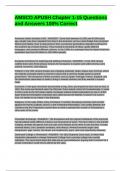Exam (elaborations)
AMSCO APUSH Chapter 1-15 Questions and Answers 100% Correct
- Course
- Institution
AMSCO APUSH Chapter 1-15 Questions and Answers 100% CorrectAMSCO APUSH Chapter 1-15 Questions and Answers 100% CorrectAMSCO APUSH Chapter 1-15 Questions and Answers 100% CorrectAMSCO APUSH Chapter 1-15 Questions and Answers 100% Correct American Indian Societies 1491 - ANSWER - Some time between 1...
[Show more]



